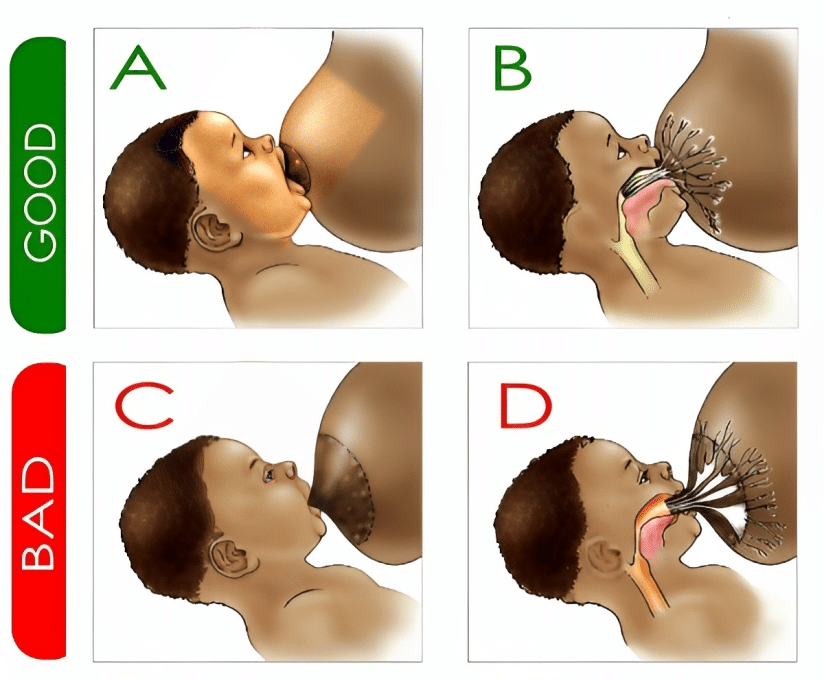How to Know If Your Baby Has a Good Latch
Breastfeeding is a natural and beneficial way to feed your baby, but it can also be challenging at times. One of the most important factors for successful breastfeeding is getting a good latch. A good latch means that your baby is able to attach to your breast properly and suckle effectively. A good latch will help your baby get enough milk, prevent nipple pain and damage, and reduce the risk of breastfeeding problems such as low milk supply, mastitis, or thrush.

But how do you know if your baby has a good latch? What are the signs that you should look for? And what can you do if your baby has a poor latch? Here, we will answer these questions and provide some tips on how to achieve a good latch.
What is a Good Latch?
A good latch is when your baby’s mouth covers most of your areola (the darker skin around your nipple) and forms a tight seal around your breast. Your baby’s tongue should be extended over the lower gum and cupped under your breast. Your baby’s lips should be flanged out like a fish, not tucked in. Your baby’s chin should touch your breast, and your baby’s nose should be slightly away from your breast. Your baby’s head should be aligned with the body, not turned to the side.
A good latch will allow your baby to draw out your milk efficiently and comfortably. You should hear or see your baby swallowing regularly, not just sucking. You should also feel a gentle tugging sensation on your breast, not pain or pinching.
What Are the Signs of a Good Latch During Breastfeeding?
There are several signs that can indicate that your baby has a good latch. Some of them are:
- The latch feels comfortable to you and does not hurt or pinch.
- Your baby’s chest and stomach rest against your body, so that your baby’s head is straight, not turned to the side.
- Your baby’s chin touches your breast.
- Your baby’s mouth opens wide around your breast, not just the nipple.
- You see little or no areola (the darker skin around the nipple), depending on the size of your areola and the size of your baby’s mouth.
- Your baby’s lips turn out like a fish.
- Your baby’s tongue cups under your breast.
- You hear or see swallowing.
- Your baby’s ears move slightly.
What Are Some Common Breastfeeding Latch Problems?
Sometimes, your baby may have difficulty latching on to your breast or may have a poor latch. This can happen for various reasons, such as:
- Prematurity or low birth weight
- Tongue-tie or lip-tie
- Flat or inverted nipples
- Engorgement or oversupply
- Nipple confusion or preference
- Illness or injury
Some of the Signs of a Poor Latch Are:
- The latch is painful or uncomfortable to you.
- Your nipples are sore, cracked, blistered, or bleeding.
- Your breasts are engorged, inflamed, or infected.
- Your baby is fussy, restless, or unsatisfied after feeding.
- Your baby makes clicking or smacking noises while feeding.
- Your baby has poor weight gain or growth.
What Can You Do To Improve Your Baby’s Latch?
If you suspect that your baby has a poor latch, don’t worry. There are some steps that you can take to improve it and make breastfeeding more enjoyable for both of you. Here are some tips:
- Seek professional help: A lactation consultant, nurse, midwife, doctor, or peer counselor can assess your situation and offer guidance and support. They can also check for any physical issues that may affect your baby’s latch, such as tongue-tie or lip-tie, and refer you to appropriate treatment if needed.
- Try different positions: Experiment with different breastfeeding positions and holds to find what works best for you and your baby. Some common positions are cradle hold, cross-cradle hold, football hold, side-lying hold, and laid-back hold. You can also use pillows, blankets, or nursing stools to support yourself and your baby.
- Use proper technique: Make sure that you bring your baby to your breast, not the other way around. Tickle your baby’s lips with your nipple to encourage them to open their mouth wide. Aim your nipple just above your baby’s top lip and make sure that their chin is not tucked into their chest. Aim their lower lip away from the base of their nipple. Once they latch on, make sure that their mouth covers most of your areola and that their lips are flanged out. If they latch on incorrectly or it hurts, gently break the suction by inserting a clean finger into their mouth and try again.
- Relax and be patient: Breastfeeding is a learning process for both you and your baby. It may take some time and practice to get it right. Don’t be discouraged or give up. Try to relax and enjoy the bonding experience with your baby. Talk to your baby, sing to them, or stroke their hair. Breathe deeply and calm yourself. Remember that you are doing a great job and that you are not alone.
Conclusion
Getting a good latch is essential for successful breastfeeding. A good latch will help your baby get enough milk, prevent nipple pain and damage, and reduce the risk of breastfeeding problems. There are some signs that can help you know if your baby has a good latch, such as comfort, swallowing, and lip flanging. There are also some steps that you can take to improve your baby’s latch, such as seeking professional help, trying different positions, using proper techniques, relaxing, and being patient. With some guidance and support, you and your baby can enjoy the benefits of breastfeeding.